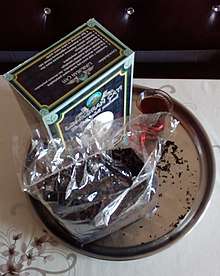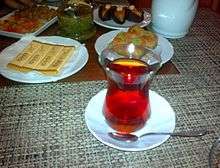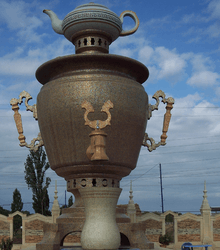Tea growing in Azerbaijan
Tea growing in Azerbaijan is concentrated in an area of 5.33 thousand square kilometers located within the Lenkeran-Astara region, including the districts of Astara, Lankaran, Masalli, Lerik, Yardimli, and Jalilabad.[1] Around 90% of Azerbaijan's tea is produced in Lankaran close to the southern border with Iran.[2] Tea was first grown around the Caspian Sea region of Azerbaijan in the 1880s. Due to its favorable climatic conditions, the region now produces 99% of the Azerbaijani tea crop.[1][2][3]

History
Towards the end of the 19th century, M. O. Novoselov planted the first set of experimental tea bushes in the Lankaran District. In 1896 he established a tea factory. and by 1900 small experimental tea plantations had been set up in the area. In 1912, Novoselov wrote Russkiye subtropiki ('Russian subtropics'), which discussed the right conditions for growing tea in the district.[1] After the failure of the enterprise in around 1920, the Azerbaijan Institute of Gardening and Subtropical Plants initiated a study on tea growing.[1] As part of their development of the tea industry, the Soviets increased tea production in the area around Lenkaran and Zakatala.[4] Around 1931-4, large-scale tea plantations were developed and.in 1937 the first packs of Azerbaijani tea were issued.
In May 1949, ministers in Moscow set out plans to develop tea plant in the Azerbaijan SSR to increase tea production in the USSR by developing the land.[1] The resultant increase in production of domestic tea in Georgia (country), Krasnodar Krai and Azerbaijan grew by 1988 to 38.5 thousand tons, mainly of black tea. A plan that was proposed to advance the tea plantations further was approved and implemented by Technical-Economic Experts’ Council of the State Plan Committee of the Soviet Union in 1953. It involved a full plan to improve production facilities, machinery tools, and irrigation, all of which resulted in increased productivity.[5] Lövəyin, Khanbulanchay, and Vileshchay are now the main contributors for supplying water.[5]
In 1982, 26 thousand tons of tea was produced,[6] with tea-growing in Azerbaijan covering an area of 9.3 thousand hectares in 1983, mostly being green tea, but with black tea commonly grown in Lankaran District. At this time 65 to 70% of the local dry tea demands were being fulfilled, with the sector employing 65,000 to 70,000 workers.[1] In 1987, the Azerbaijan Government implemented an edict to enhance tea production in the country, with a plan to expand tea production to 21,000 hectares by 2000. so increasing green tea yield to 80–90,000 tons and dry tea yield to 20–22,000 tons.[1] However, events such as the collapse of the USSR and the Nagorno-Karabakh War, tea production in Azerbaijan fell, reducing 1,200 tons by 1995.[1] Later, with the development of market relations in Azerbaijan, tea production began to revive through ties with Turkey and the United Arab Emirates.
Current production
Azerbaijan's tea plantations lie between the Caspian Sea and the Talysh Mountains, in a region where the subtropical climate and humidity make it an ideal location growing tea.[3][7] The main tea-growing areas are situated in the districts of Lankaran, Astara, Lerik, Masalli, Zakatala, and Balakan. Azerbaijani tea is produced mainly for internal consumption, but it is also exported to Turkey, the Russian republic of Dagestan, and Georgia.
In 2017, President Ilham Aliyev visited Lankaran to attend a Republican meeting about improving the production of tea, rice, and citrus fruits in the region. During the visit he reinforced that the main focus should be to increase the export of locally grown and processed tea to help Azerbaijan's balance of trade. The government has in recent years provided financial support for the purchase of machinery and technical tools, but experts have argued that increased government investment is needed if maximum levels of production are to be reached. The government set out its aims in its report State Program for the Development of Agricultural Cooperatives in the Republic of Azerbaijan for 2017 – 2022 (July 2017).[5]
In the Sheki-Zagatala economic-geographical region growth in the sector is relatively weak.[8][9] Recent reports suggest the weather conditions in Southern Caucasus might be able to support new tea plantations, and areas have been earmarked by the government for future expansion.[1] Government initiatives to help reinvigorate production are expected by 2021 to have led to a doubling of the size of land used to grow tea.[5]
Tea industry
The tea-packing factory Sun Tea Azerbaijan, which has been in continuous operation since 1996, is the largest tea-packing factory in the CIS. The regional leader in South Caucasus, its annual production is around 15 thousand tons. The company produces a pure green tea leaf at its primary tea treatment factories at Lenkaran and Astara, which deal with leaf drying, twisting, fermenting, dry sorting and packaging. It mainly produces packaged teas, green teas, and fruit teas. Tea is exported to the Caucasus, central Asia, and the CIS, primarily Russia.
For its premier brand, Azerçay, the company uses leaves from locally situated tea plantations, or from India, Vietnam, or Kenya. Its factory in Baku obtains high-quality Ceylon teas through its Inter Tea from Sri Lanka. The factory mainly uses a mixture of Ceylon and Indian teas to make several types of tea, each with a different quality and composition.
Tea culture

Azerbaijani greatly enjoy drinking tea, known as chay, and still maintain their ancient and traditional tea ceremonies when drinking what is their main beverage of daily life. It is common in Azerbaijan for a guest to be welcomed firstly by black tea, often served in a pair-shaped crystal Armudu glass, which is said to keep tea hot longer at the bottom and cool more rapidly at the top. In Azerbaijani culture, serving tea at the beginning of a meal is a symbol of hospitality. Sweetened tea is preferred to regular tea. By custom, sugar is never dissolved directly as a method of sweetening it. Instead, a sugar cube is dipped slightly into the tea before it is sipped, a custom that began in medieval times, when the presence of Toxins in the tea was detected in this way, when they reacted with the sugar. Azerbaijani people also enjoy flavouring their tea with spices, such as cinnamon, lemon or ginger. Tea is made using fragrant herbs to produce corn silk tea, mint tea, cinnamon tea, saffron tea, ginger tea, dog-rose tea, hawthorn tea, and thyme tea. Tea is often served with jams made from figs, strawberries, apricots, walnuts, and blackberries, called dishleme ('bite'), a tradition designed to help the flow of conversation.[2]
Because of the high demand for tea in Azerbaijan, almost every neighborhood has a tea house, known as a chaykhana. The tea house's chaykhor ('tea connoisseur') always knows that a good tea has to have a deep burgundy colour. Purrengi ('velvet tea') is the most common type of tea served in such establishments.[2]
Historically, chaykhan were mainly male-dominated establishments, as women were not permitted not enter public places. The term chaykhana denotes a place where men have tea, and this cultural tradition persists in Azerbaijan in the same way that Pubs in Britain once excluded women. Chaykhanas maintain the tradition of being places where men go to discuss politics or other important issues over a game of backgammon.[10]
The drinking of tea in Azerbaijan often features during important occasions such as the celebration of an engagement, a marriage, the birth of a child, or a funeral.[2][4]
Law on tea-growing
Azerbaijani laws on tea growing have established the legal basis for the regulation of tea growing, its production, processing, and turnover, and also the quality assurance of tea in the country. Its main aims are to stimulate investment and cooperation, expand leasing and agro-services, improve the quality and quantity of exports, protect the domestic market, and improve both social security and ecological equilibrium of production. The law was approved by the former President of Azerbaijan, Heydar Aliyev on 17 December 2002, principally to provide incentives for tea growing, create economic and legal guarantees to safeguard against unfair competition, and meet international standards.
A state program on the development of tea growing from 2018 to 2027 was approved by presidential decree on 12 February 2018, with the aim of developing tea production, increasing the export potential of the industry, and ensuring the employment prospects of the rural population.[11][12]
Duties of the state in the field of tea-growing
According to the Law of Azerbaijani Republic about tea growing, the duties of the state include the following guidelines:[11]
- Adopt regulatory legal acts on the regulation of measures for the organization of tea growing, cultivation of tea landing materials, production, turnover, and improvement of quality of tea products.
- Study, predict the market of tea products, develop and perform target state programs on the development of the industry.
- Stimulate based on target programs of cultivation of tea plantations on lands, suitable for tea, recovery of the existing tea plantations, the advancement of tea landing materials, improvements of scientific ensuring tea growing, increase in export and development of quality of tea products.
- Exercise the state quality control and turnover of tea products.
- Perform other tasks established by the legislation.
See also
References
- "TEA-GROWING IN AZERBAIJAN: THE PRESENT AND PROSPECTS".
- "Tea Drinking in Azerbaijani Style". caspiannews.com. Retrieved 25 April 2019.
- "INTERNATIONAL GEOGRAPHER. Lankaran natural-economic zone. Lankaran-Astara economic region".
- "Azerbaijan among leaders in tea drinking". AzerNews.az. 24 May 2016. Retrieved 25 April 2019.
- "Azerbaijani tea has high export potential". CBC.AZ. Retrieved 26 April 2019.
- "Growth in tea production observed in Azerbaijan". CBC.AZ. Retrieved 25 April 2019.
- "Postcards from Azerbaijan: The tradition of tea".
- Михайлович Семёнов, Владимир (2002). Азербайджанский чай // Чайные рецепты и чайные секреты. Олма-Пресс. pp. 110. — 351. ISBN 9785224038268.
- Капанадзе and Керкадзе (1983). "Полиплоидный чай". Природа Издательство Наука: 44.
- Əhmədov (2010). "Azərbaycan çayı. Ətirli-ədviyyatlı bitkilərdən hazırlanan müalicəvi çaylar" (PDF).
- "Çayçılıq haqqında AZƏRBAYCAN RESPUBLİKASININ QANUNU" (PDF).
- "Azərbaycan Respublikasında çayçılığın inkişafına dair 2018–2027-ci illər üçün Dövlət Proqramı"nın təsdiq edilməsi haqqında AZƏRBAYCAN RESPUBLİKASI PREZİDENTİNİN SƏRƏNCAMI" (PDF).
